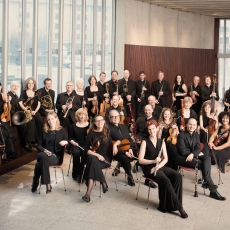Berlioz Symphonie Fantastique - SCO & Ticciati - Audio Video Club of Atlanta
Robin Ticciati, the youthful new principal conductor of the Scottish chamber Orchestra, gives a commendable account of himself in his debut recording with the orchestra, comprising Hector Berlioz' Symphonie Fantastique, with the overture to Béatrice et Bénédict as a chaser. The main feature, of course, is the symphony. Here Ticciati leads the SCO, augmented to 65 pieces for this work, in a nicely nuanced and characterized performance that preserves the work's essential tautness and its surprising regard for symphonic form, albeit of a decidedly literary and romantic cast that marked a bold departure from the classical symphony. The playing by the SCO is strong enough to have been a credit to a much larger ensemble. In sum, this account of the Fantastique is competitive in what is, admittedly, a very fast field.
We all know the story by now. Berlioz' programme is the story of a young artist of vivid imagination and morbid temperament, prone to what Berlioz calls "the wave of passions" (la vague des passions). In despair over a lost love, this young man (presumably a surrogate for the composer) attempts to take his life through an overdose of opium. The dose does not prove lethal, but plunges our hero into a series of reveries and dreams, some beautiful and tinged by nostalgia and passionate yearnings, others outright nightmares, in which a long musical theme, some 40 bars in length, is associated with the artist's beloved, recurring in various guises throughout the symphony. This is Berlioz' famous idée fixe (apparently his own coinage), which he uses to give cyclic unity to the work. With its built-in rising and falling patterns, this theme beautifully epitomizes the successive moods of aspiration and dark despair which the hero experiences in his emotionally vulnerable and highly nervous states of mind.
Perhaps because the present performance is so highly nuanced, it is also fairly lengthy, about 55 minutes in all, so that Ticciati's skill in maintain the pacing and tautness of a long-limbed work is put to the test. He passes the test in the opening movement (Rêveries - Passions) and the third (Scène aux champs, Scene in the Fields), the movements with the moments where bad performances of the Fantastique usually go home to die. And Ticciati and the orchestra certainly capture the excitement and grotesquerie of the final two movements, the Marche au supplice (March to the Scaffold), in which the dreamer witnesses his own execution, and the Songe d'une nuit de sabbat (Dream of a Witches' Sabbath). The build-up to the fall of the guillotine and the roar of the crowd, the impudence of the servants of evil powers and their and mockery of the chant for the dead are all conveyed vividly in musical terms. Individual instrumental touches that are so important to the total effect such as the striking of the tubular bells, the vulgar dance tune played by the C clarinet, and the eerie col legno bowing by the violins, come through optimally in the final satanic scene.


